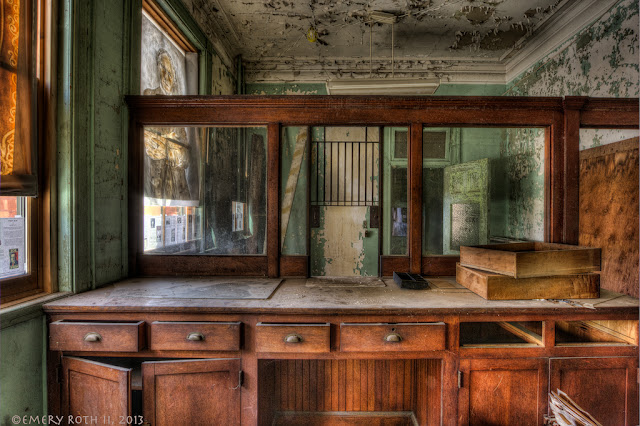PHOTOGRAPHER'S JOURNAL:
It is literally true, the opera house is no longer for skating. Wagner's principles of perfect site lines in theater design called for raked seating. Inside the Sterling Auditorium one feels the aspirations of the town swelling, striving to grow into a city. It features a democratic seating plan. Although the inexpensive top balcony seats are only benches, hard like church pews unless you bring your own cushion, those seated there and standing behind them are promised the same unobstructed contact with the proceedings.
In April of 1889 the state legislature resolved the three-town dispute by making Ansonia a township, independent of Derby. The course was set; in 1893 Ansonia was incorporated as a city; Derby was made a city the following year. Huntington became a city in 1915 and incorporated with the town of Huntington as the City of Shelton in 1919, but by then, although they remained rivals, the three cities were cooperating on a variety of common needs, and the Sterling Opera House was booked regularly, and the current Episcopal and Methodist churches were taking up their axis points with the Congregationalists beside the Sterling on the town Green.
Whether you came to see the latest melodrama or vaudeville show or to hear the great Caruso or the Swedish Nightingale, Jenny Lind, the master of ceremonies at the Sterling and in auditoriums everywhere was a new mechanical contraption of levers and strings stretched over a heavy, iron frame called a fortepiano, or loudsoft. They had to be loud to fill a concert hall and soft to caress a tear. Like clocks, pianos use many brass parts. Pianos became an important niche of the Brass Valley economy.
Look inside the fine houses on the Birmingham Green and along the town's central streets, named a half century earlier for Sheldon Smith's daughters, Caroline, Minerva, and Elizabeth, and for Anson Phelps' wife, Olivia. There, inside the velvet and crystal parlors with their chiming mantle clocks, were pianos and often children practicing, and in Derby and Ansonia and towns throughout the northeast merchants and professionals also had parlors, and once you had a parlor, the next acquisition was often a piano with a bit of tatting and a ceramic or glass compote rattling on the top.
My grandmother was a pianist. Though my great grandfather was only a cigar maker in Hartford, she was good enough to be offered a scholarship to study with the great Horatio Parker at Yale which she turned down to marry my grandfather, a haberdasher. My great grandparents raised 6 children in half of a two-family house they rented from a cousin. The story is told in an old letter of how my grandmother, Sadie, avoided chores by playing piano for her father as he read the newspaper in the parlor. Parker is most famous today for attacks against him by his most famous pupil, Charles Ives of Danbury.
The piano had become more than an MC; it was one of the stars of the show. The great age of the piano had begun and virtuoso pianists were striving to succeed the great Franz Liszt by performing feats of pyrotechnics at the keyboard, and they were followed by legions of fans; entrepreneurs staged Monster Concert spectacles with dozens of pianos shaking walls and trying to stay together. The Sterling Piano Company had grown to occupy 15 buildings, and across the river in Shelton another manufacturer was offering inexpensive pianos with machines inside that let the pianos magically play by themselves, no lessons required.
Like the seating at the opera house, the distribution of swelling aspirations was similarly democratic with the toughest rump for those at the back but with prospects swelling for all. Once one possessed a mantle clock, the next essential tech toy was often a piano whether it was to play the old hymns, new rags, or strive for the Moonlight Sonata.
See previous blog post for link to source information:
Ansonia Opera House interior:









.jpg)



